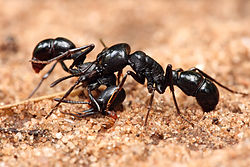Ponerinae
| Ponerinae Temporal range:
| |
|---|---|

| |
| Fighting Harpegnathos saltator | |
| Scientific classification | |
| Domain: | Eukaryota |
| Kingdom: | Animalia |
| Phylum: | Arthropoda |
| Class: | Insecta |
| Order: | Hymenoptera |
| Family: | Formicidae |
| Subfamily: | Ponerinae Lepeletier, 1835 |
| Type genus | |
| Ponera Latreille, 1804
| |
| Diversity[1] | |
| 59 genera | |

Ponerinae is a subfamily of ants in the Poneromorph subfamilies group, with about 1,600 species in 47 extant genera, including Dinoponera gigantea - one of the world's largest species of ant. Mated workers have replaced the queen as the functional egg-layers in several species of ponerine ants. In such queenless species, the reproductive status of workers can only be determined through ovarian dissections.
They are most easily identified from other subfamilies by a constricted gaster (abdomen). They are rare examples of stinging ants.[2]
Genera
- Platythyreini Emery, 1901
- Platythyrea Roger, 1863
- Ponerini Lepeletier de Saint-Fargeau, 1835
- Anochetus Mayr, 1861
- †Archiponera Carpenter, 1930
- Asphinctopone Santschi, 1914
- Austroponera Schmidt & Shattuck, 2014
- Belonopelta Mayr, 1870
- Boloponera Fisher, 2006
- Bothroponera Mayr, 1862
- Brachyponera Emery, 1900
- Buniapone Schmidt & Shattuck, 2014
- Centromyrmex Mayr, 1866
- †Cephalopone Dlussky & Wedmann, 2012[3]
- Cryptopone Emery, 1893
- †Cyrtopone Dlussky & Wedmann, 2012[3]
- Diacamma Mayr, 1862
- Dinoponera Roger, 186
- Dolioponera Brown, 1974
- Ectomomyrmex Mayr, 1867
- Emeryopone Forel, 1912
- Euponera Forel, 1891
- Feroponera Bolton & Fisher, 2008
- Fisheropone Schmidt & Shattuck, 2014
- Hagensia Forel, 1901
- Harpegnathos Jerdon, 1851
- Hypoponera Santschi, 1938
- Iroponera Schmidt & Shattuck, 2014
- Leptogenys Roger, 1861
- Loboponera Bolton & Brown, 2002
- Mayaponera Schmidt & Shattuck, 2014
- Megaponera Mayr, 1862
- Mesoponera Emery, 1900
- †Messelepone Dlussky & Wedmann, 2012[3]

Messelepone leptogenoides male - Myopias Roger, 1861
- Neoponera Emery, 1901
- Odontomachus Latreille, 1804
- Odontoponera Mayr, 1862
- Ophthalmopone Forel, 1890
- Pachycondyla Smith, 1858
- Paltothyreus Mayr, 1862
- Parvaponera Schmidt & Shattuck, 2014
- Phrynoponera Wheeler, 1920
- Plectroctena Smith, 1858
- Ponera Latreille, 1804
- Promyopias Santschi, 1914
- †Protopone Dlussky, 1988[3]
- Psalidomyrmex André, 1890
- Pseudoneoponera Donisthorpe, 1943
- Pseudoponera Emery, 1900
- Rasopone Schmidt & Shattuck, 2014
- Simopelta Mann, 1922
- Streblognathus Mayr, 1862
- Thaumatomyrmex Mayr, 1887
- incertae sedis
- †Afropone Dlussky, Brothers & Rasnitsyn, 2004
- †Eogorgites Hong, 2002
- †Eoponerites Hong, 2002
- †Furcisutura Hong, 2002
- †Longicapitia Hong, 2002
- †Ponerites Dlussky & Rasnitsyn, 2003
- †Taphopone Dlussky & Perfilieva, 2014
References
- ^ Bolton, B. (2015). "Ponerinae". AntCat. Retrieved 9 January 2015.
- ^ Hoffman, Donald R. "Ant venoms" Current Opinion in Allergy and Clinical Immunology 2010, vol. 10, pages 342-346. doi:10.1097/ACI.0b013e328339f325
- ^ a b c d Dlussky, G.M.; Wedmann, S. (2012). "The poneromorph ants (Hymenoptera, Formicidae: Amblyoponinae, Ectatomminae, Ponerinae) of Grube Messel, Germany: High biodiversity in the Eocene". Journal of Systematic Palaeontology. 10 (4): 725–753. doi:10.1080/14772019.2011.628341. – via Taylor & Francis (subscription required)
External links
 Media related to Ponerinae at Wikimedia Commons
Media related to Ponerinae at Wikimedia Commons

